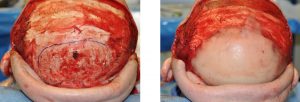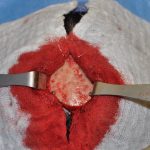When one thinks of cosmetic surgery, the thought rarely goes to any form of skull contouring. While the world is full of a wide variety of head shapes, there is no uniform size or measurement to determine a pleasing cranial contour. But there is a certain oblong and curvilinear shape to most of the skull. The forehead, which is really the front part of the skull, has some very specific desired shapes and contours that are very gender-specific, but the rest of the skull has less well-defined determinants of being pleasing in appearance.
Despite the comparatively obscure location of the back of the head (occiput) compared to the forehead, not everyone is entirely pleased with this portion of their skull shape. The typical concern is that the back of the head is too flat without adequate projection. Whether it be the entire occiput or limited to just the crown area (upper occiput), this is a legitimate cosmetic concern for those so affected. For anatomic clarification, the bony portion of the occiput actually stops at about the level of the middle of the ear. The rest of the back of the head is muscle and other soft tissue.
The most effective method of occipital skull contouring is augmentative, putting a material on top of the bone to build it out. This is a common form of cranioplasty that has a long history in the forehead, it is just less commonly done on the back of the head. There are multiple ways to perform an occipital augmentation cranioplasty and they differ primarily in the material used and the incisional approach to get it there. Each has their own distinct advantages and some disadvantages.


Cosmetic contouring can be done on most areas of the skull. Occipial augmentation cranioplasty can be done to build out a flat spot or entire back of the head. Regardless of the material and the incision used, it is a simple procedure for a patient to go through with very minimal recovery. Patients report having a headache for a few days but no real pain. Once can wash their hair within 48 hours. Some mild swelling can be expected and the final result can be fully appreciated within 6 weeks after the procedure. All of the cranioplasty materials used are permanent so the change in skull contour will be maintained over one’ lifetime.
Dr. Barry Eppley
Indianapolis, Indiana


